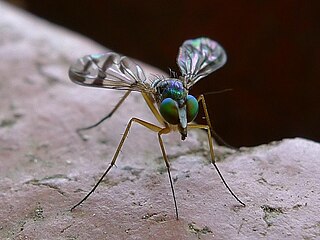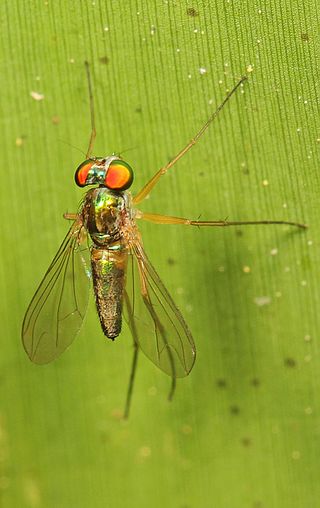Abbemyia is a genus of flies in the family Dolichopodidae, known from Australia and New Caledonia. It is named after the French entomologist Abbé Octave Parent, who studied the family Dolichopodidae.

Austrosciapus is a genus of flies in the family Dolichopodidae. It is mainly found in Australia, though some species are also known from New Zealand, French Polynesia, Norfolk Island and the Hawaiian Islands.

Chrysosoma is a genus of flies in the family Dolichopodidae. It is a large genus, with more than 200 species distributed in the Old World and Oceania.
Dytomyia is a genus of flies in the family Dolichopodidae. It is known from Australia, Madagascar and Kenya, with an undescribed species from Papua New Guinea.

Heteropsilopus is a genus of flies in the family Dolichopodidae.
Krakatauia is a genus of flies in the family Dolichopodidae.
Mesorhaga is a genus of flies in the family Dolichopodidae.
Narrabeenia is a genus of flies in the family Dolichopodidae, living in Australia and named for Narrabeen, New South Wales.
Naufraga hexachaeta is a species of fly in the family Dolichopodidae. It is the only member of the genus Naufraga, and is found in New Zealand.
Negrobovia is a genus of flies in the family Dolichopodidae found in Australia. It is named in honor of O.P. Negrobov.

Parentia is a large genus of flies in the family Dolichopodidae.
Pilbara octava is a species of fly in the family Dolichopodidae from Australia, and the only member of the genus Pilbara. The genus is named after the Pilbara region of Western Australia, where P. octava was found. In particular, the only known location of P. octava is at Millstream, Fortescue River.
Plagiozopelma is a genus of flies in the family Dolichopodidae.
Pseudoparentia is a genus of flies in the family Dolichopodidae. It is known from Australia.

Sciapodinae is a subfamily of flies in the family Dolichopodidae.
Pindaia is a genus of fly in the family Dolichopodidae from the Australasian realm. The genus is named after the New Caledonian place name "Pindai".
Lapita is a genus of flies in the family Dolichopodidae. It is known from New Caledonia, Fiji and Vanuatu.

Sciapodini is a tribe of flies in the family Dolichopodidae.
Mesorhagini is a tribe of flies in the family Dolichopodidae.

Chrysosomatini is a tribe of flies in the family Dolichopodidae.





